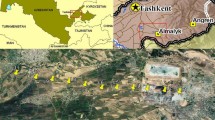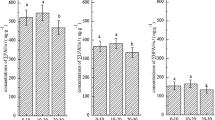Abstract
Polycyclic aromatic hydrocarbons (PAHs) in an AMS 14C-dated permafrost soil core extracted from continuous permafrost zone were measured to reconstruct the pollution history from the early Holocene (ca. 15480 a BP) and its potential risks under climate changes were evaluated in northeast China. Total PAH concentrations varied from 209 to 2161 ng/g through the core, which were moderately contaminated in the surface but heavily contaminated historically. Factor analysis indicated that volcanic activity, diagenesis from biological precursors and palaeo forest fires were dominant PAH sources, while petroleum emission was identified in the active layer due to the construction of China–Russia oil pipeline. Significant increases in 5-ring, 6-ring and 7 carcinogenic PAHs (p < 0.05) were observed from surface to the interface of the active layer and ice-rich permafrost layer, showing a selective downward migration in the active layer which might be effected by the repetitive cycles of freezing and thawing. Results implied that PAHs in the ice-rich permafrost layer could lead to an unpredictably serious consequence under the further climate warming.







Similar content being viewed by others
References
Aislabie J, Balks M, Astori N, Stevenson G, Symons R (1999) Polycyclic aromatic hydrocarbons in fuel-oil contaminated soils, Antarctica. Chemosphere 39(13):2201–2207
Anderson DM, Pusch R, Penner E (1978) Physical and thermal properties of frozen ground. In:Andersland OB, Anderson DM eds. Geotechnical engineering for cold regions. McGraw-Hill, New York, NY, pp 37–102
Bai ZD, Tian MZ, Wu FD, Li TJ (2005) Yanshan, Gaoshan-Two active volcanoes of the volcanic cluster in Arshan, Inner Mongolia. Earthq Res China 19:402–408
Bond MJ, Carr J (2018) Permafrost thaw and implications for the fate and transport of tritium in the Canadian north. J Environ Radioactiv 192:295–311
CCME (Canadian Council of Ministers of the Environment) (2010) Polycyclic aromatic hydrocarbons. Canadian soil quality guidelines for protection of environmental and human health. Can Soil Qual Guidel
Chen PF, Li CL, Kang SC, Rupakheti M, Panday AK, Yan FP, Li QL, Zhang QG, Guo JM, Ji ZM, Rupakheti D, Luo W (2017) Characteristics of particulate-phase polycyclic aromatic hydrocarbons (PAHs) in the atmosphere over the Central Himalayas. Aerosol Air Qual Res 17:2942–2954
Chen XF, Wu ZZ, Chen WT, Kang RX, He XZ, Miao YC (2019) Selection of key indicators for reputation loss in oil and gas pipeline failure event. Eng Fail Anal 99:69–84
Cheng GD, Jin HJ (2013) Permafrost and groundwater on the Qinghai-Tibet Plateau and in northeast China. Hydrogeol J 21:5–23
Curtosi A, Pelletier E, Vodopivez CL, Mac Cormack WP (2007) Polycyclic aromatic hydrocarbons in soil and surface marine sediment near Jubany Station (Antarctica). Role of permafrost as a low-permeability barrier. Sci Total Environ 383:193–204
Daly GL, Wania F (2005) Organic contaminants in mountains. Environ Sci Technol 39:385–398
Dauner ALL, Hernandez EA, MacCormack WP, Martins CC (2015) Molecular characterization of anthropogenic sources of sedimentary organic matter from Potter Cove, King George Island, Antarctica. Sci Total Environ 502:408–416
Dobbins RA, Fletcher RA, Benner JBA, Hoeft S (2006) Polycyclic aromatic hydrocarbons in flames, in diesel fuels, and in diesel emissions. Combust Flame 144:773–781
Gao WF, Yao YL, Liang H, Song LQ, Sheng HC, Cai TJ, Gao DW (2019) Emissions of nitrous oxide from continuous permafrost region in the Daxing’an Mountains, Northeast China. Atmos Environ 198:34–45
Guo YD, Song CC, Tan WW, Wang XW, Lu YZ (2019) Export of dissolved nitrogen in catchments underlain by permafrost in northeast China. Sci Total Environ 660:1210–1218
Jin HJ, Chang XL, Luo DL, He RX, Lü LZ, Yang AZ, Guo DX, Chen XM, Harris S (2016) Evolution of permafrost in Northeast China since the Late Pleistocene. Sciences in Cold and Arid Regions 8:269–296
Jin HJ, Hao JQ, Chang XL, Zhang JM, Yu QH, Qi JL, Lü LZ, Wang SL (2010) Zonation and assessment of frozen-ground conditions for engineering geology along the China-Russia crude oil pipeline route from Mo’he to Daqing, Northeastern China. Cold Reg Sci Techno 64:213–225
Jin HJ, Yu QH, Lü LZ, Guo DX, He RX, Yu SP, Sun GY, Li YW (2007) Degradation of permafrost in the Xing’anling Mountains, northeastern China. Permafrost Periglac Process 18:245–258
Ji XW, Abakumov E, Polyako V, Xie XC, Wei DY (2019) The ecological impact of mineral exploitation in the Russian Arctic: a field-scale study of polycyclic aromatic hydrocarbons (PAHs) in permafrost-affected soils and lichens of the Yamal-Nenets autonomous region. Environ Pollut 255:1–12
Killops SD, Massoud MS (1992) Polycyclic aromatic hydrocarbons of pyrolytic origin in ancient sediments: evidence for Jurassic vegetation fires. Org Geochem 18:1–7
Klánová J, Matykiewiczová N, Máčka Z, Prošek P, Láska K, Klán (2008) Persistent organic pollutants in soils and sediments from James Ross Island, Antarctica. Environ Pollut 152:416–423
Li GY, Sheng Y, Jin HJ, Ma W, Qi JL, Wen Z, Zhang B, Mu YH, Bi GQ (2010) Development of freezing-thawing processes of foundation soils surrounding the China–Russia crude oil pipeline in the permafrost areas under a warming climate. Cold Reg Sci Technol 64:226–234
Li J, Yuan GL, Wu MZ, Sun Y, Wang GH (2017a) Evidence for persistent organic pollutants released from melting glacier in the central Tibetan Plateau, China. Environ Pollut 220:178–185
Li QL, Kang SC, Wang NL, Li Y, Li XF, Dong ZW, Chen PF (2017b) Composition and sources of polycyclic aromatic hydrocarbons in cryoconites of the Tibetan Plateau glaciers. Sci Total Environ 574:991–999
Lin H, Wang XP, Gong P, Ren J, Wang CF, Yuan XH, Wang L, Yao TD (2017) The influence of climate change on the accumulation of polycyclic aromatic hydrocarbons, black carbon and mercury in a shrinking remote lake of the southern Tibetan Plateau. Sci Total Environ 601–602:1814–1823
Liu Y, Chen L, Huang QH, Li WY, Tang YJ, Zhao JF (2009) Source apportionment of polycyclic aromatic hydrocarbons (PAHs) in surface sediments of the Huangpu River, Shanghai, China. Sci Total Environ 407:2931–2938
Long ER, Macdonald DD, Smith SC, Calder FD (1995) Incidence of adverse biological effects within ranges of chemical concentrations in marine and estuarine sediments. Environ Manage 19:81–97
Luo W, Gao JJ, Bi X, Xu L, Guo JM, Zhang QG, Romesh KY, Giesy JP, Kang SC (2016) Identification of sources of polycyclic aromatic hydrocarbons based on concentrations in soils from two sides of the Himalayas between China and Nepal. Environ Pollut 212:424–432
Maliszewska-Kordybach B (1996) Polycyclic aromatic hydrocarbons in agricultural soils in Poland: preliminary proposals for criteria to evaluate the level of soil contamination. Appl Geochem 11:121–127
Marquès M, Sierra J, Drotikova T, Mari M, Nadal M (2017) Concentrations of polycyclic aromatic hydrocarbons and trace elements in Arctic soils: a case-study in Svalbard. Environ Res 159:202–211
McCarthy K, Walker L, Vigoren L (2004) Subsurface fate of spilled petroleum hydrocarbons in continuous permafrost. Cold Reg Sci Technol 38:43–54
Nabbefeld B, Grice K, Summons RE, Hays LE, Cao CQ (2010) Significance of polycyclic aromatic hydrocarbons (PAHs) in Permian/Triassic boundary sections. Appl Geochem 25:1374–1382
Nisbet ICT, Lagoy PK (1992) Toxic equivalency factors (TEFs) for polycyclic aromatic hydrocarbons (PAHs). Regul Toxicol Pharm 16:290–300
Potapowicz J, Szumińska D, Szopińska M, Polkowska Ż (2019) The influence of global climate change on the environmental fate of anthropogenic pollution released from the permafrost Part I. Case study of Antarctica. Sci Total Environ 651:1534–1548
Song CC, Wang XW, Miao YQ, Wang JY, Mao R, Song YY (2014) Effects of permafrost thaw on carbon emissions under aerobic and anaerobic environments in the Great Hing’an Mountains, China. Sci Total Environ 487:604–610
Sun L, Zang SY (2013) Relationship between polycyclic aromatic hydrocarbons (PAHs) and particle size in dated core sediments in Lake Lianhuan, Northeast China. Sci Total Environ 461–462:180–187
US EPA (1996) Test methods for evaluating solid waste, physical/chemical methods, SW846, Revision 3. Office of Solid Waste and Emergency Response, Washington
Valle MD, Jurado E, Dachs J, Sweetman AJ, Jones KC (2005) The maximum reservoir capacity of soils for persistent organic pollutants: implications for global cycling. Environ Pollut 134:153–164
Wang XW, Song CC, Sun XX, Wang JY, Zhang XH, Mao R (2013a) Soil carbon and nitrogen across wetland types in discontinuous permafrost zone of the Xiao Xing’an Mountains, northeastern China. Catena 101:31–37
Wang XW, Song CC, Wang JY, Miao YQ, Mao R, Song YY (2013b) Carbon release from Sphagnum peat during thawing in a montane area in China. Atmos Environ 75:77–82
Wang RW, Yousaf B, Sun RY, Zhang H, Zhang JM, Liu GJ (2016) Emission characterization and δ13C values of parent PAHs and nitro-PAHs in size-segregated particulate matters from coal-fired power plants. J Hazard Mater 318:487–496
Wania F (2003) Assessing the potential of persistent organic chemicals for long-range transport and accumulation in polar regions. Environ Sci Technol 37:1344–1351
Wania F, Westgate J (2008) On the mechanism of mountain cold-trapping of organic chemicals. Environ Sci Technol 42:9092–9098
Yang SZ, Jin HJ, Yu SP, Chen YC, Hao JQ, Zhai ZY (2010) Environmental hazards and contingency plans along the proposed China-Russia Oil Pipeline route, Northeastern China. Cold Reg Sci Technol 64:271–278
Zhao YW, Fan QC (2010) Yanshan and Gaoshan volcanoes in the Da Xing’an Mountain range—a new eruption style. Seismol Geol 32:28–37. (in Chinese with English abstract)
Zhao ZY, Zhuang YX, Gu JD (2012) Abundance, composition and vertical distribution of polycyclic aromatic hydrocarbons in sediments of the Mai Po Inner Deep Bay of Hong Kong. Ecotoxicology 21:1734–1742
Acknowledgements
This study was supported by the National Natural Science Foundation of China (Nos. 41971151 and 41401589), the Natural Science Foundation of Heilongjiang Province of China (Nos. YQ2019D005 and TD2019D002), the Fundamental Research Funds for the Central Universities (No. 2017-KYYWF-0139), the Program for the Training of Young Innovative Talents in Ordinary Colleges and Universities of Heilongjiang Province (No. UNPYSCT-2018182), the Doctoral Scientific Research Foundation of Harbin Normal University (No. XKB201903), and the Graduate Innovative Programs Foundation of Harbin Normal University (No. HSDSSCX2018-04).
Author information
Authors and Affiliations
Corresponding authors
Ethics declarations
Conflict of interest
The authors declare that they have no conflict of interest.
Ethical approval
This article does not contain any studies with human participants or animals performed by any of the authors.
Informed consent
Informed consent was obtained from all individual participants included in the study.
Additional information
Publisher’s note Springer Nature remains neutral with regard to jurisdictional claims in published maps and institutional affiliations.
Rights and permissions
About this article
Cite this article
Li, Y., Zang, S., Zhang, K. et al. Occurrence, sources and potential risks of polycyclic aromatic hydrocarbons in a permafrost soil core, northeast China. Ecotoxicology 30, 1315–1324 (2021). https://doi.org/10.1007/s10646-020-02285-2
Accepted:
Published:
Issue Date:
DOI: https://doi.org/10.1007/s10646-020-02285-2




